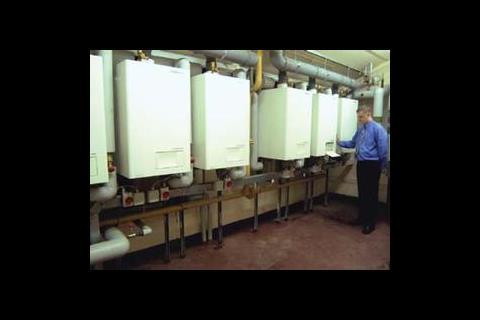These days, it is becoming increasingly difficult to treat boilers this way. New legislation which should be in force before the end of the decade will mean that boilers systems have to be checked regularly – so there's no chance of them lying neglected from one year to the next.
Also, occupiers should be getting the message about energy efficiency, which should make them more aware of how proper maintenance can not only stop equipment break-downs, it can also ensure efficient running of their plant.
One good example of how better treatment of boiler systems leads to greater efficiency and savings for the user is at Trinity College in Cambridge. The college's senior mechanical engineer Martin Noble, and his colleague Peter Heath, senior electrical engineer, had been dealing with the university's old boiler systems for many years, tackling increasing problems: "One boiler room was thirty years old, and had been added to frequently. It wasn't up to the job any more. We were getting plus-four hour recovery times on hot water, on a good day," explains Noble. One major issue was that Trinity College had added a large building onto its site in the 1990s. Instead of adding another space for plant, everything was simply crammed into the existing boiler plant room. For Noble and Heath, this made maintenance very difficult: "We had four different control systems in the same boiler house, all linked together. Maintenance was a nightmare." Additionally, more pressure was put on the heating and hot water systems, as visitor numbers have risen over the years.
Using the CIBSE guide on size of boiler houses based on kW output, the engineers calculated that in fact the original boiler house of 30 years ago, had been the correct size. "But once another 600 kW was added in there, it wasn't so good," says Noble.
The two engineers recommended to the University that a whole new plant room needed to be created. This new area does not replace the whole college's services needs and is in fact only one small section of what Noble and Heath oversee. It represents the heating and hot water for around 400 rooms. Nevertheless, it is a start on the road to modernisation.
Long-term benefits
"We put forward a recommendation of what we felt needed to be done," says Heath. "We said that the plant was proving less than economical to run." In fact, the Trinity engineers are fortunate in that they have long-standing records of the college services and related costs going back many years which gives them a good idea of costs. The new plant room project was agreed, but delayed for a year because of local work by British Gas. "We calculated that that year the boilers cost us about £7000. We had to have pumps rebuilt and four new controllers installed, just to keep it all going," says Noble.
When it came to choice of boiler, the college benefited from Noble and Heath's expertise. "We knew we wanted a particular kind of boiler, because of experience we've had with previous boilers," explains Noble. "We chose Viessmann as a brand we could rely on. Also, we don't like boilers that have back-end protection and low water content. Some of our systems are 30 years old, and just not suitable to work with that. We would be running huge volumes of electricity just to circulate water through the boiler. I'd rather have a large water content boiler sitting there, so it doesn't matter if there's nothing flowing through it. It will just sit there and run itself."
The engineers did in-depth calculations to show what cost savings they could make with this equipment. They compared their selection against modular boilers, which are already in place in some parts of the college. "We would have needed 20 modular boilers. We already have similar in the college and we're talking about a week's work to service 18 of them – as opposed to the four new ones we selected."
The College, which is itself 400 years old, can take a long-term view of costs. Maintenance is a large part of this, and was integral to Noble and Heath's costings. Noble adds: "Sometimes, an engineer comes up with a design and never sees the outcome. We're here, and we do. We can go back over time and pull out costs for many years. On that basis you can work out the real cost of new plant. Things sound good in theory, but real life isn't always like that!"
Trinity's engineers were also careful to manage the new plant room project carefully, right down to overseeing the commissioning. "We insisted from the outset that everybody sat down together – electrical contractor, mechanical services contractor, consultant and other specialists. We all put our cards on the table, that way no one could say 'they didn't tell us that'. It has worked, and any problems we have had have been solved quickly," says Heath.
The project was on a tight timescale from the second week of June to early September. During that time hot water still had to be supplied to the whole site, as the college is continually occupied. Temporary boilers, plate exchangers and pipework were all running through the plantroom at the same time as it was being ripped out.
The homefront
The Trinity project demonstrates the importance of understanding client needs, and thinking long term about maintenance needs. The College benefits from its own on-site experts Noble and Heath – few clients have this luxury.
At the other end of the country in Salford, near Manchester, the city council is also renewing boilers. The project is part of a policy by Salford City Council to replace conventional boilers with condensing units in its properties.
The project is wide ranging. The city of Salford covers 37 square miles and the heating and mechanical services team of the council is responsible for 66 social services buildings, including homes for the elderly, children's homes and offices. The team also covers 80 buildings for development services which incorporates museums, art galleries and sports centres. There are also 28 000 homes and 32 sheltered and communal schemes.
The estimated gas costs for tenants in council housing is £10 million a year. For major city buildings the gas bill is around £567 000 per annum. The city has a scheme for replacing boilers on a 20-year cycle, budgets allowing, with priority given to possible service problem sites. The policy on condensing boilers began in 1984 and since then 60 major buildings and 2500 homes have switched to condensing units.
The city of Salford heating services team estimates huge savings as a result of this policy. On major buildings the average running costs savings on condensing installations is 25%. For housing, this rises to 30% – with a high of 54%.
One example of recent replacement with condensing boilers is the Alexander Gardens sheltered housing scheme which comprises 35 flats, communal areas and a laundry. Heating was originally from three cast iron boilers – 350 kW in total. They provided constant temperature circuit to flats and dhw cylinders at 71°C to 82°C.
The new equipment consisted of six Vitodens 200 condensing boilers and two Vitocell high recovery boilers (the latter for the laundry and communal areas). The new system includes a cascade controller and weather compensation to match flow temperatures and boiler outputs to demand. The resulting savings in energy consumption is 20%; representing savings of £1300 pa. There was no additional capital cost of the replacement equipment, so pyaback has been immediate.
Graham Piper, head of the team says that condensing boilers have brought big savings to residents and the city council. "Applying condensing boilers and controls, irrespective of the system, saves never less than 20% and usually much more. For large projects, where a boiler has to be changed anyway, the payback period can be measured in months." Piper adds that from the installers point of view, condensing boilers are no more difficult to install and maintain than conventional boilers.
"Going for the lowest cost, non-condensing choice, on boiler replacement is bad economics, and bad for the environment," says Piper.
Source
Building Sustainable Design

























No comments yet